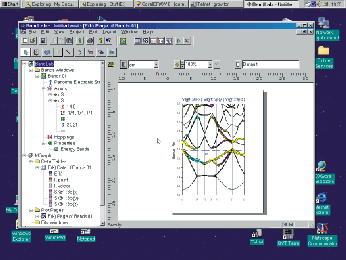
Welcome to MStudio MindLab, the first scientific software for Windows systems which performs electronic structure calculations of crystalline solids.
A set of properties which can be computed directly within MindLab
and further visualized by it includes:
(i) Crystal Group calculations: by setting the atomic positions
the BandLab shows crystal group operations found for given configuration.
(ii) Fat Bands: fully colored visualization of separated orbital characters
on top of band structures.
Examples can be found in the DataBase/Solids section.
(iii) Density of States: MindLab computes and visualizes densities of states , total and orbital resoved.
(iv) Hoppings: computations of Hopping integrals for tight-binding fits
(either those which are desired or all possible)
can be done directly within MindLab.
(v) Optical properties (e1, e2, and electron energy loss spectra)
(vi) 2D visualizations of charge density and full potential.
(vii) Full 3D countor plots and 3D visualisations
of the charge density, full potential, Fermi surfaces (compatibility of
3D graphic accelerators with OpenGL is required to use these options)
(viii) Crystal structure visualizer. (compatibility of
3D graphic accelerators with OpenGL is required to use these options)
Added features include
complete support of the LDA+U method for correlated electronic systems.
Several bugs have been also fixed with the present version.

A set of properties coming with the following versions of the MindLab
will include
(a) Dynamical susceptibility, chi(q,omega), calculations for desired
wave vectors q and omega.
(b) Free atom solver.
(c) Impurity solver using dynamical mean-field theory for strongly correlated systems.
The engine of the MindLab is a program called LmtART. LmtART is a scientific program developed at the Max-Planck Institute for Solid State Research in Stuttgart, Germany. It performs electronic structure calculations of crystalline solids using various methods. LmtART is is a free software, most of its source codes can be downloaded from this site. A comprehensive overview on how to use this program is also provided. Refer to specific license agreement and copyright notice when using the LmtART code.
The LmtART is an executable file which reads the input data, performs band structure calculation, and stores the output files. The MindLab controls this process, it prepares input for the LmtART using dialog windows, and starts running LmtART program as a separate thread. When the calculation is finished, LmtART notifies the MindLab, and the output files read by the framework can be visualized by simple mouse click operations.While running LmtART program for complicated compounds can be rather slow (it depends how many atoms per unit cell is chosen), the MindLab can be used to prepare the input files, after which they can be copied to another more powerful computer where the LmtART can be executed in much faster way. After run is performed, the output files can be copied back to the PC and analyzed quickly by the MindLab. All input/output files of LmtART are formatted ASCII files, and therefore system independent.
Check out www.physics.ucdavis.edu/~mindlab for all downloads and upgrades.